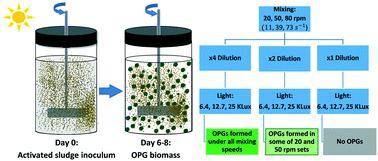当前位置:
X-MOL 学术
›
Environ. Sci.: Water Res. Technol.
›
论文详情
Our official English website, www.x-mol.net, welcomes your feedback! (Note: you will need to create a separate account there.)
Hydrodynamic granulation of oxygenic photogranules
Environmental Science: Water Research & Technology ( IF 5 ) Pub Date : 2020-12-29 , DOI: 10.1039/d0ew00957a Joseph G. Gikonyo 1, 2, 3 , Abeera A. Ansari 1, 2, 3 , Ahmed S. Abouhend 1, 2, 3 , John E. Tobiason 1, 2, 3 , Chul Park 1, 2, 3
Environmental Science: Water Research & Technology ( IF 5 ) Pub Date : 2020-12-29 , DOI: 10.1039/d0ew00957a Joseph G. Gikonyo 1, 2, 3 , Abeera A. Ansari 1, 2, 3 , Ahmed S. Abouhend 1, 2, 3 , John E. Tobiason 1, 2, 3 , Chul Park 1, 2, 3
Affiliation

|
Oxygenic photogranules (OPGs), granular assemblages of phototrophic and chemotrophic microbes, offer a promising biotechnology for wastewater treatment with self-aerating potential. Currently, the seed OPG is produced under hydrostatic conditions with activated-sludge inoculum. We investigated the development of OPGs under hydrodynamic conditions employing batches with different light, shear, and inoculum conditions. The results demonstrated hydrodynamic granulation of OPGs from activated sludge, presenting opportunities for rapid (less than 8 days) and bulk development. From the matrix of conditions investigated, we found that granulation occurs only with some combinations of different magnitudes of these input energies. For example, ×4 dilute inoculum combined with low light supported granulation under the different shear conditions utilized. However, ×4 dilution inoculum with high light and high shear did not support granulation. This observed disparity in applied conditions suggests that OPG granulation ensues only with favorable interaction of variable induced energy pressures coupled with biological response selecting for spheroidal aggregates. Multi-regression analysis on temporal changes in the ratio of sludge volume index for 5 min to 30 min settling, a metric for granulation, confirmed the intercorrelation of these energy inputs on OPG granulation. This granulation scheme, dependent on goldilocks interaction of selection pressures, can potentially be extended to other granules applied in wastewater treatment.
中文翻译:

含氧光颗粒的水力制粒
有氧光颗粒(OPG)是光养和化学养分微生物的颗粒组合,为具有自曝气潜力的废水处理提供了一种有前途的生物技术。目前,OPG种子是在静水条件下用活性污泥接种物生产的。我们研究了在水动力条件下采用不同光,剪切和接种条件的批次的OPG的开发。结果表明,活性污泥中OPG的流体动力学造粒,为快速(少于8天)和批量开发提供了机会。从研究的条件矩阵中,我们发现,只有在这些输入能量的大小不同的某些组合下才会发生造粒。例如,在所使用的不同剪切条件下,×4稀释接种物与低光照支持的制粒相结合。但是,高光高剪切的×4稀释接种物不能支持造粒。在应用条件下观察到的这种差异表明,只有在可变感应能量压力的良好相互作用以及对球状聚集体的生物响应选择的基础上才能实现OPG颗粒化。对5分钟到30分钟的污泥体积指数(沉降)指标的时间变化进行多元回归分析,这是造粒的一项指标,证实了这些能量输入与OPG造粒之间的相互关系。取决于选择压力的金鸡菊相互作用,这种制粒方案可以潜在地扩展到废水处理中应用的其他颗粒。在应用条件下观察到的这种差异表明,只有在可变感应能量压力的良好相互作用以及对球状聚集体的生物响应选择的基础上才能实现OPG颗粒化。对5分钟到30分钟的污泥体积指数(沉降)指标的时间变化进行多元回归分析,这是造粒的一项指标,证实了这些能量输入与OPG造粒之间的相互关系。取决于选择压力的金鸡菊相互作用,这种制粒方案可以潜在地扩展到废水处理中应用的其他颗粒。在应用条件下观察到的这种差异表明,只有在可变感应能量压力的良好相互作用以及对球状聚集体的生物响应选择的基础上才能实现OPG颗粒化。对5分钟到30分钟的污泥体积指数(沉降)指标的时间变化进行多元回归分析,这是造粒的一项指标,证实了这些能量输入与OPG造粒之间的相互关系。取决于选择压力的金鸡菊相互作用,这种制粒方案可以潜在地扩展到废水处理中应用的其他颗粒。作为制粒的一项指标,证实了这些能量输入与OPG制粒之间的相互关系。取决于选择压力的金鸡菊相互作用,这种制粒方案可以潜在地扩展到废水处理中应用的其他颗粒。作为制粒的一项指标,证实了这些能量输入与OPG制粒之间的相互关系。取决于选择压力的金鸡菊相互作用,这种制粒方案可以潜在地扩展到废水处理中应用的其他颗粒。
更新日期:2021-01-07
中文翻译:

含氧光颗粒的水力制粒
有氧光颗粒(OPG)是光养和化学养分微生物的颗粒组合,为具有自曝气潜力的废水处理提供了一种有前途的生物技术。目前,OPG种子是在静水条件下用活性污泥接种物生产的。我们研究了在水动力条件下采用不同光,剪切和接种条件的批次的OPG的开发。结果表明,活性污泥中OPG的流体动力学造粒,为快速(少于8天)和批量开发提供了机会。从研究的条件矩阵中,我们发现,只有在这些输入能量的大小不同的某些组合下才会发生造粒。例如,在所使用的不同剪切条件下,×4稀释接种物与低光照支持的制粒相结合。但是,高光高剪切的×4稀释接种物不能支持造粒。在应用条件下观察到的这种差异表明,只有在可变感应能量压力的良好相互作用以及对球状聚集体的生物响应选择的基础上才能实现OPG颗粒化。对5分钟到30分钟的污泥体积指数(沉降)指标的时间变化进行多元回归分析,这是造粒的一项指标,证实了这些能量输入与OPG造粒之间的相互关系。取决于选择压力的金鸡菊相互作用,这种制粒方案可以潜在地扩展到废水处理中应用的其他颗粒。在应用条件下观察到的这种差异表明,只有在可变感应能量压力的良好相互作用以及对球状聚集体的生物响应选择的基础上才能实现OPG颗粒化。对5分钟到30分钟的污泥体积指数(沉降)指标的时间变化进行多元回归分析,这是造粒的一项指标,证实了这些能量输入与OPG造粒之间的相互关系。取决于选择压力的金鸡菊相互作用,这种制粒方案可以潜在地扩展到废水处理中应用的其他颗粒。在应用条件下观察到的这种差异表明,只有在可变感应能量压力的良好相互作用以及对球状聚集体的生物响应选择的基础上才能实现OPG颗粒化。对5分钟到30分钟的污泥体积指数(沉降)指标的时间变化进行多元回归分析,这是造粒的一项指标,证实了这些能量输入与OPG造粒之间的相互关系。取决于选择压力的金鸡菊相互作用,这种制粒方案可以潜在地扩展到废水处理中应用的其他颗粒。作为制粒的一项指标,证实了这些能量输入与OPG制粒之间的相互关系。取决于选择压力的金鸡菊相互作用,这种制粒方案可以潜在地扩展到废水处理中应用的其他颗粒。作为制粒的一项指标,证实了这些能量输入与OPG制粒之间的相互关系。取决于选择压力的金鸡菊相互作用,这种制粒方案可以潜在地扩展到废水处理中应用的其他颗粒。


























 京公网安备 11010802027423号
京公网安备 11010802027423号